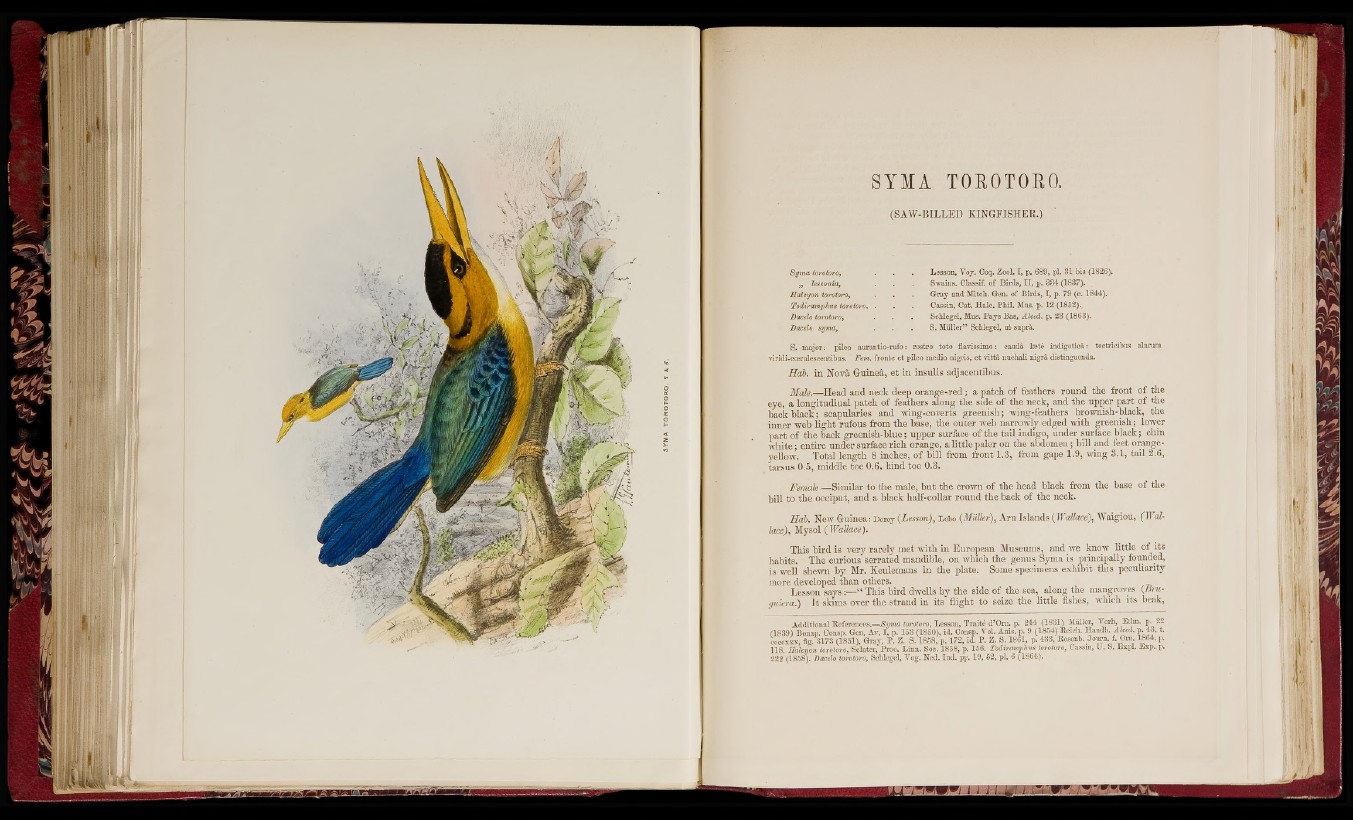
SYMA TOROTORO,
(SAW -B IL L ED K IN G F ISH E R .)
Syma torotoro,
„ hssonia,
Ilaleyon torotoro,
Todiramphus torotoro.
Dacelo torotoro,
Dacelo syma.
Lesson, Voy. Coq. Zool. I, p. 689, pl. 31 bis (1826).
Swains. Classif. of Birds, II, p. 334 (1837).
Gray and Hitch. Gen. of Birds, I, p. 79 (c. 1844).
Cassin, Cat. Hale. Phil. Mus. p. 12 (1852).,
Schlegel, Mus. Pays Bas, Alced. p. 23 (1863).
S. MiiUev” Sclilegel, ut suprà.
S. major: pileo aurantio-rufo: rostro toto flavissimo: caudà lætè indigoticâ: tectricibus alarum
viridi-eoerulcscentibus. Fem. fronte et pileo medio nigris, et vitt.à nuchaii nigrâ distinguenda.
Hah. iü Novâ Gumeâ, e t in insulis adjacentibus.
Maie.—Head and neck deep orange-red ; a patch o f feathers ro u n d the fro n t o f the
eye, a lo n g itu d in a l p atch o f feathers along the side o f the neck, and the upper p a rt o f the
back b lack ; scapularies and wing-coverts g reen ish ; wing-feathers brownish-black, the
in n e r web lig h t rufous from th e base, th e o u ter web narrowly edged with green ish ; lower
p a rt o f the back greenish-blue; upper surface o f the tail indigo, under surface black; chin
white ; en tire u n d e r surface rich orange, a little p a le r on th e abdomen ; b ill and feet orange-
yellow. Total len g th 8 inches, o f b ill from fro n t 1.3, from gape 1.9, wing 3.1, tail 2.6,
tarsu s 0.5, middle toe 0.6, hind toe 0.3.
Female.—Similar to th e male, b u t th e crown o f th e head black from th e base o f the
bill to th e occiput, and a black half-collar ro u n d th e back of the neck.
Hah. New Guinea: Dorey (Lesson), Lobo (MiìMer), A ru Islands ( Tí a/í'ace), "Waigiou, (Wallace),
Mysol (Wallace).
This b ird is very rare ly met w ith in European Museums, and ive know little o f its
habits. The curious serrated mandible, on which th e genus Syma is p rincipally founded,
is well she'wn b y Mr. Keulemans in th e plate. Some specimens ex h ib it this peculiarity
more developed th an others.
Lesson says :— “ Th is bird dwells b y th e side of th e sea, _ alon^ the mangroves (Bru-
gniera.) I t skims over the stran d in its flig h t to seize the little fishes, which its beak,
AcUlitional Kefercnces.—Rî/Hia iofotero, Les&on, Traite d’Orn. p. 244 (1831) Müller, Verb, Etlm. p. 22
(1839) Bonap. Consp. Gen. Av. 1, p. 153 (1850), id. Consp. Vol. Anis. p. 9 (1854) Eeich Handb. Alced. p. 43, t.
ccccxxx, fig. 3173 (1851), Gray, P. Z. S. 1858, p. 172, id. P. Z. S. 1861, p. 438, Rosenb. Jomn. f. Orn 1864. p.
118, Halcyon torotoro, Sclater, Proc. Linn. Soc. 1858, p. 156, Todiramplms torotoro, Cassai, U. S. Expl. Exp. p.
222 (1858). Dacelo torotoro, Schlegel, Vog. Ned. Ind. pp. 19, 52, pl. 6 (1864).
, u
U'V 'I *